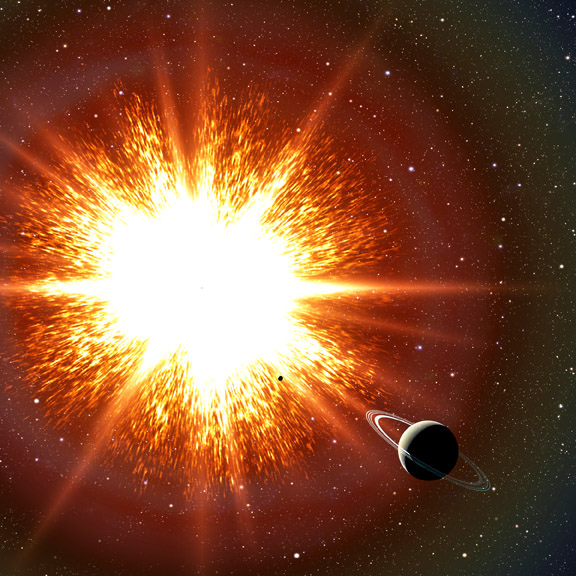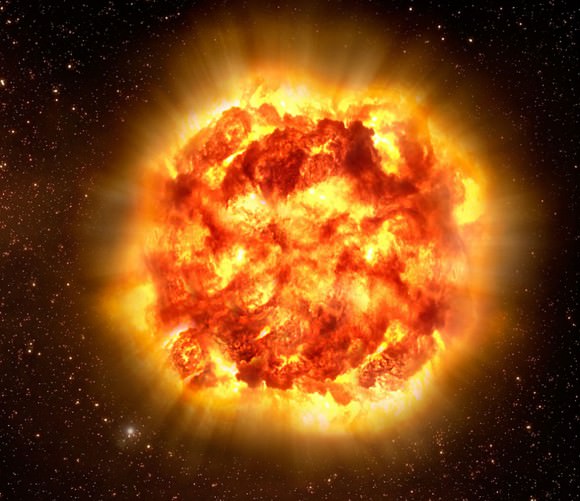We’ve written quite a few articles on what happens when massive stars fail as supernovae. Here’s a quick recap.
A star with more than 8 times the mass of the Sun runs out of usable fuel in its core and collapses in on itself. The enormous amount of matter falling inward creates a dense remnant, like a neutron star or a black hole. Oh, and an insanely powerful explosion, visible billions of light-years away.
There are a few other classes of supernovae, but that’s the main way they go out.
But it turns out some supernovae just don’t bring their A-game. Instead hitting the ball out of the park, they choke up at the last minute.
They’re failures. They’ll never amount to anything. They’re a complete and utter disappointment to me and your mother. Oh wait, we were talking about stars, right.
So, how does a supernova fail?

In a regular core collapse supernova, the infalling material pushes the star denser and denser until it reaches the density of 5 billion tons per teaspoon of matter. The black hole forms, and a shockwave ripples outward creating the supernova.
It turns out that the density and energy of the shockwave on its own isn’t enough to actually generate the supernova, and overcome the gravitational force pulling it inward. Instead, it’s believed that neutrinos created at the core pile up behind the shockwave, and give it the push it needs to blast outward into space.
In some cases, though, it’s believed that this additional energy doesn’t show up. Instead of rebounding from the core of the star, the black hole just gobbles it all up. In a fraction of a second, the star is just… gone.
According to astronomers, it might be the case that 1/3rd of all core collapse supernovae die this way, which means that a third of the supergiant stars are just disappearing from the sky. They’re there, and then a moment later, they’re not there.

Seriously, imagine the forces and energy it must take to swallow an entire red supergiant star whole. Black holes are scary.
Astronomers have gone looking for these things, and they’ve actually been pretty tricky to find. It’s like one of those puzzles where you try to figure out what’s missing from a picture. They studied images of galaxies taken by the Hubble Space Telescope, looking for bright supergiant stars which disappeared. In one survey, studying a large group of galaxies, they only turned up a single candidate.
But they only surveyed a handful of galaxies. To really get serious about searching for them, they’ll need better tools, like the Large Synoptic Survey Telescope due for first light in just a few years. This amazing instrument will survey the entire sky every few nights, searching for anything that changes. It’ll find asteroids, comets, variable stars, supernovae, and now, supergiant stars that just disappeared.
We’ve talked about failed supernovae. Now let’s take a few moments and talk about the complete opposite: super successful supernovae.
When a star with more than 8 times the mass of the Sun explodes as a supernova, it leaves behind a remnant. For the lower mass star explosions, they leave behind a neutron star. If it’s a higher mass star, they leave behind a black hole.
But for the largest explosions, where the star had more than 130 times the mass of the Sun, the supernova is so powerful, so complete, there’s no remnant behind. There’s an enormous explosion, and the star is just gone.
No black hole ever forms.

Astronomers call them pair instability supernovae. In a regular core collapse supernova, the layers of the star collapse inward, producing the highly dense remnant. But in these monster stars, the core is pumping out such energetic gamma radiation that it generates antimatter in the core. The star explodes so quickly, with so much energy, it totally overpowers the gravity pulling it inward.
In a moment, the star is completely and utterly gone, just expanding waves of energy and particles.
Only a few of these supernovae have ever been observed, and they might explain some hypernovae and gamma ray bursts, the most powerful explosions in the Universe.
Beyond 250 times the mass of the Sun, however, gravity takes over again, and you get enormous black holes.
As always, the Universe behaves more strangely than we ever thought possible. Some supernova fail, completely imploding as a black hole. And others detonate entirely, leaving no remnant behind. Trust the Universe to keep mixing it up on us.

